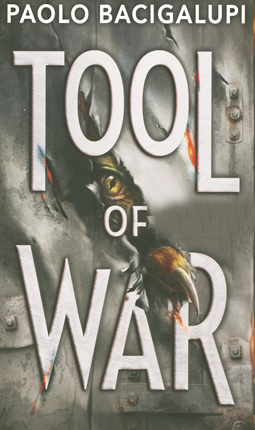| Tool of war Author: Bacigalupi, Paolo | ||
| Price: $6.50 | ||
Summary:
In a future beset with rising seas, corporate government, and constant civil war, a bioengineered half-man/half-beast super-soldier who calls himself Tool breaks his conditioning to overcome his genetically enhanced sense of loyalty to the corporation that created him and seeks revenge against his old masters.
| Accelerated Reader Information: Interest Level: UG Reading Level: 5.20 Points: 12.0 Quiz: 192416 | Reading Counts Information: Interest Level: 9-12 Reading Level: 5.30 Points: 19.0 Quiz: 72334 | |
Reviews:
School Library Journal (+) (08/01/17)
Booklist (08/01/17)
The Bulletin of the Center for Children's Books (00/07/17)
The Hornbook (00/11/17)
Full Text Reviews:
Booklist - 08/01/2017 Five years after The Drowned Cities (2012), Bacigalupi returns to his award-winning Ship Breaker series. This opens with a rare moment of peace in the Drowned Cities. Moments later, Havoc missiles rain down death on Tool and his young army, turning humans and city into ash. The Mercier Corporation and General Carora have finally located the DNA-enhanced Tool and are desperate to annihilate their renegade augment. The action is nonstop as Tool is marched through a series of brutal battles, meeting main characters from the earlier books along the way. The number of plot conveniences and narrow escapes is almost as high as the body count as Tool seeks revenge on his corporate makers. The central issue of Tool’s humanity is burdened by plot contradictions that overwhelm character development, and the searing passion of the earlier books seems missing. Still, Bacigalupi’s action scenes are brilliantly cinematic, powering the pacing with breathtaking superhero stunts. Tool, as ever, is a character impossible to forget, and all loose ends are tied up in an epilogue. - Copyright 2017 Booklist.
School Library Journal - 08/01/2017 Gr 10 Up—The third entry in his award-winning dystopian series, following Ship Breaker and The Drowned Cities, tells the story of Tool the "augment," a genetically engineered "half-man" made up of a cocktail of genetic material—human, dog, tiger. Augments are designed to be the ultimate killing machines while remaining fiercely loyal to his creators. However, once Tool discovers that he can suppress his submissive instincts, he rebels against his creators and splinters off from his augment pack to lead an army of soldier boys—human child soldiers—to capture the Drowned Cities. Tool's creators find him and wipe out his army, which forces him back into hiding. With the help of a new pack—a band of teen merchant sailors—and old allies, Tool resumes his desrtructive mission. Bacigalupi proves once again that he is a master of world-building; the world he created in the previous two books is just as desolate, violent, and intriguing in this installment. The tension—from the time Tool's creators rain fire down upon him in the Drowned Cities, to when Tool finally comes face-to-face with the man who built him—is relentless throughout the narrative, and the lack of primary character development (perhaps a result of expecting readers to have plowed through the first two books) allows for the introduction and development of supporting characters, such as Jones, a junior analyst and young prodigy for Mercier Corporation who is helping track Tool down. The amount of violence and bloodshed makes this more suitable for an older audience. VERDICT A strong, entertaining continuation of Bacigalupi's postapocalyptic series; teens will be hoping for future installments. Hand to those who devoured the first two books.—Tyler Hixson, Brooklyn Public Library - Copyright 2017 Publishers Weekly, Library Journal and/or School Library Journal used with permission.



